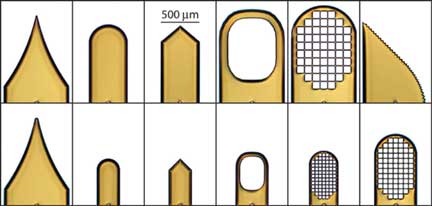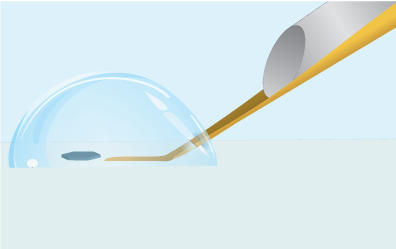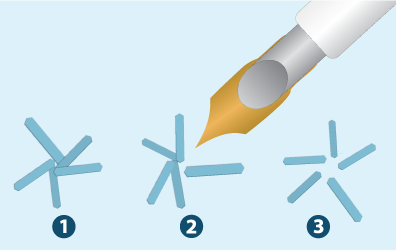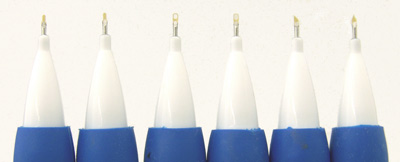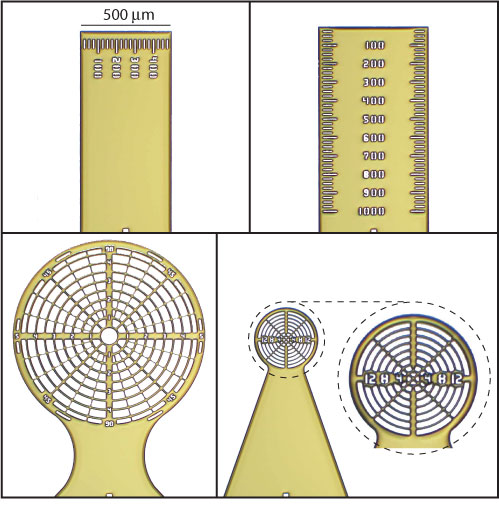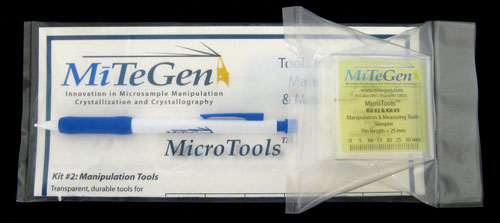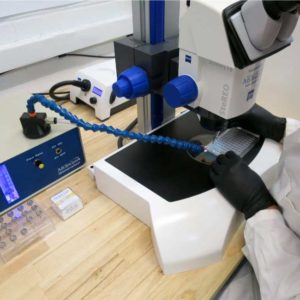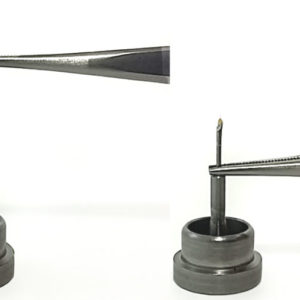MicroTools
These tools have tips made from soft, flexible microfabricated polymer films. Tip curvature gives them rigidity, but they can still easily be flexed to conform to a well or slide surface. These tools are far less likely to damage fragile samples than metal microtools, and are optically and X-ray transparent. Use for protein crystals, single cells and other small samples.
MicroTools Kit 1 Information MicroTools Kit 2 Information MicroTools Kit 3 InformationProduct Information
Kit 3-
MicroTool™ Kit 3 contains 20 tools for sample measurements. Two tool designs allow measurement of linear sample dimensions, and two allow measurement of both linear and angular dimensions. Use them to accurately measure small and fragile samples with minimal chance of sample damage. The tool tips are 10 micrometers thick and are both optically and X-ray transparent. Measurements using microscope reticles are rendered inaccurate if the sample dimension of interest is not perpendicular to the viewing direction, or if the sample is contained in an optically distorting liquid drop. To get accurate measurements, just position these transparent tools next to, under or on top of your sample. Dispense sample-containing liquid onto the tool or dip the tool into sample-containing liquid or powder. Each tool is mounted on a 0.025"/ 0.64 mm diameter nonmagnetic solid stainless steel rod. Hold them in a standard 0.7 mm mechanical pencil (included with each kit), or in a micromanipulator. Each kit contains: Horizontal MicroRuler™: Five 500 micrometer wide horizontal rulers with 25 micrometer gradations. Vertical MicroRuler™: Five 1000 micrometer long vertical rulers with 25 micrometer gradations. Large MicroProtractor™: Five 1000 micrometer diameter tools for measuring angles and radial distances/dimensions, with 15 degree and 50 micrometer gradations. Use to measure facet angles on crystals, the major and minor axes of ellipsoidal samples, or to specify the polar coordinates of multiple samples on a single tool. Small MicroProtractor™: Five 320 micrometer diameter tools for measuring angles and radial distances/dimensions, with 30 degree and 20 micrometer gradations.Kit 3-
MicroTool™ Kit 3 contains 20 tools for sample measurements. Two tool designs allow measurement of linear sample dimensions, and two allow measurement of both linear and angular dimensions. Use them to accurately measure small and fragile samples with minimal chance of sample damage. The tool tips are 10 micrometers thick and are both optically and X-ray transparent. Measurements using microscope reticles are rendered inaccurate if the sample dimension of interest is not perpendicular to the viewing direction, or if the sample is contained in an optically distorting liquid drop. To get accurate measurements, just position these transparent tools next to, under or on top of your sample. Dispense sample-containing liquid onto the tool or dip the tool into sample-containing liquid or powder. Each tool is mounted on a 0.025"/ 0.64 mm diameter nonmagnetic solid stainless steel rod. Hold them in a standard 0.7 mm mechanical pencil (included with each kit), or in a micromanipulator. Each kit contains: Horizontal MicroRuler™: Five 500 micrometer wide horizontal rulers with 25 micrometer gradations. Vertical MicroRuler™: Five 1000 micrometer long vertical rulers with 25 micrometer gradations. Large MicroProtractor™: Five 1000 micrometer diameter tools for measuring angles and radial distances/dimensions, with 15 degree and 50 micrometer gradations. Use to measure facet angles on crystals, the major and minor axes of ellipsoidal samples, or to specify the polar coordinates of multiple samples on a single tool. Small MicroProtractor™: Five 320 micrometer diameter tools for measuring angles and radial distances/dimensions, with 30 degree and 20 micrometer gradations.Kit 3-
MicroTool™ Kit 3 contains 20 tools for sample measurements. Two tool designs allow measurement of linear sample dimensions, and two allow measurement of both linear and angular dimensions. Use them to accurately measure small and fragile samples with minimal chance of sample damage. The tool tips are 10 micrometers thick and are both optically and X-ray transparent. Measurements using microscope reticles are rendered inaccurate if the sample dimension of interest is not perpendicular to the viewing direction, or if the sample is contained in an optically distorting liquid drop. To get accurate measurements, just position these transparent tools next to, under or on top of your sample. Dispense sample-containing liquid onto the tool or dip the tool into sample-containing liquid or powder. Each tool is mounted on a 0.025"/ 0.64 mm diameter nonmagnetic solid stainless steel rod. Hold them in a standard 0.7 mm mechanical pencil (included with each kit), or in a micromanipulator. Each kit contains: Horizontal MicroRuler™: Five 500 micrometer wide horizontal rulers with 25 micrometer gradations. Vertical MicroRuler™: Five 1000 micrometer long vertical rulers with 25 micrometer gradations. Large MicroProtractor™: Five 1000 micrometer diameter tools for measuring angles and radial distances/dimensions, with 15 degree and 50 micrometer gradations. Use to measure facet angles on crystals, the major and minor axes of ellipsoidal samples, or to specify the polar coordinates of multiple samples on a single tool. Small MicroProtractor™: Five 320 micrometer diameter tools for measuring angles and radial distances/dimensions, with 30 degree and 20 micrometer gradations.You may also like…
-
Watershed – Optimized Crystal Harvesting
Prevent loss or damage to the crystals that you’ve spent time growing and optimizing. The Watershed™... -
Reusable Goniometer Base Styles
Quickly assemble MiTeGen Mounts, Loops, and Meshes into bases for crystal harvesting, without using glue or...

